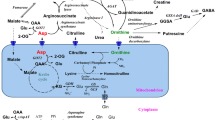Abstract
Intraperitoneal injection into rats of 5.5 mM/kg ofdl-homocysteine (free base) ordl-homocysteine thiolactone · HCl resulted in violent convulsions (approx. 50%) and some fatalities (approx. 15%), following a short, initial period of depressant activity. Metabolically related metabolites (viz. methionine, serine, homoserine, cysteine and homocystine) showed no convulsant activity and virtually no lethal effects at doses as high as 7.4 mM/kg. At 7.4 mM/kg, homocysteine and its lactone resulted in 95% convulsions and 90% fatalities. These obervations point to a structural factor for convulsant activity indl-homocysteine not found in the related methionine metabolites tested. The half-maximal convulsant dose (CD50) was 750 (698–806) mg/kg and the half-maximal lethal dose (LD50) was 840 (794–889) mg/kg, both values having Litchfield-Wilcoxon confidence limits of 19/20. Prior intraperitineal injection of large doses (14.8 mM/kg) of homoserine, serine, betaine, glycine and glucose protected against convulsions and death induced by the CD50 dose (i.e. 750 mg/kg) ofdl-homocysteine. Our findings indicate that, of all the major metabolites of methionine tested, homocysteine would seem to be the only one which is epileptogenic and the most toxic (to the point of lethality).
Similar content being viewed by others
References
H. Sprince, J. A. Josephs, jr. andC. R. Wilpizeski,Neuropharmacological Effects of 1,4-Butanediol and Related Congeners Compared with Those of Gamma-Hydroxybutyrate and Gamma-Butyrolactone, Life Sci.5, 2041–2052 (1966).
G. Ungar andD. V. Romano,Sulfhydryl Groups in Resting and Stimulated Rat Brain; Their Relationship with Protein Structure, Proc. Soc. Exptl Biol. Med.97, 324–326 (1958).
V. V. Portugalov, E. L. Dovedova andV. G. Skrebitsky,On Some Mechanisms Regulating the Chemical Activity of the Neuron Mitochondria, J. Histochem. Cytochem.10, 213–221 (1962).
W. Pollin, P. V. Cardon, Jr. andS. S. Kety,Effects of Amino Acid Feedings in Schizophrenic Patients Treated with Iproniazid, Science133, 104–105 (1961).
G. G. Brune andH. E. Himwich,Effects of Methionine Loading on the Behavior of Schizophrenic Patients, J. Nerv. Ment. Dis.134, 447–450 (1962).
F. Alexander, G. C. Curtis III, H. Sprince andA. P. Crosley,L-Methionine and L-Tryptophan Feedings in Non-Psychotic and Schizophrenic Patients with and without Tranylcypromine, J. Nerv. Ment. Dis.137, 135–142 (1963).
G. G. Haydu, A. Dhrymiotis, C. Korenyi andL. Goldschmidt,Effects of Methionine and Hydroxychloroquine in Schizophrenia, Am. J. Psychiat.122, 560–564 (1965).
G. G. Brune,Tryptophan Metabolism in Psychoses, inAmines and Schizophrenia (Ed. H. E. Himwich, S. S. Kety and J. R. Smythies, Pergamon Press, New York 1967), p. 87–96.
A. J. Friedhoff andE. van Winkle,New Developments in the Investigation of the Relationship of 3,4-Dimethoxyphenylethylamine to Schizophrenia, inAmines and Schizophrenia (Ed. H. E. Himwich, S. S. Kety and J. R. Smythies, Pergamon Press, New York 1967), p. 19–21.
T. L. Perry, S. Hansen, L. MacDougall andP. D. Warrington,Sulfur-Containing Amino Acids in the Plasma and Urine of Homocystinurics, Clin. Chim. Acta15, 409–420 (1960).
J. A. Wada andH. Ikeda,The Susceptibility to Auditory Stimuli of Animals Treated with Methionine Sulfoximine, Exptl Neurology15, 157–165 (1966).
E. H. Jenney andC. C. Pfeiffer,The Convulsant Effect of Hydrazides and the Antidotal Effect of Anticonvulsants and Metabolites, J. Pharmac. Exptl Ther.122, 110–123 (1958).
M. A. Medina,The In Vivo Effects of Hydrazines and Vitamin B 6 on the Metabolism of Gamma-Aminobutyric Acid, J. Pharmac. Exptl Ther.140, 133–137 (1963).
A. Meister,Biochemistry of the Amino Acids, 2nd ed., vol. 1 (Academic Press, New York, N.Y. 1964), p. 221.
J. T. Litchfield jr. andF. Wilcoxon,A Simplified Method of Evaluating Dose-Effect Experiments, J. Pharmac. and Exptl Ther.96, 99–113 (1949).
V. DuVigneaud,A Trail of Research in Sulfur Chemistry and Metabolism (Cornell University Press, Ithaca, N.Y. 1952), p. 89–125.
J. S. Roth andJ. B. Allison,The Effects of Feeding Excess dl-Methionine and Choline Chloride to Rats on a Casein Diet, J. Biol. Chem.183, 173–178 (1950).
H. P. Cohen, H. C. Choitz andC. P. Berg,Response of Rats to Diets High in Methionine and Related Compounds, J. Nutrition64, 555–569 (1958).
H. Sprince,Metabolic Interrelationships of Tryptophan and Methionine in Relation to Mental Illness, inAmines and Schizophrenia (Ed. H. E. Himwich, S. S. Kety and J. R. Smythies, Pergamon Press, New York 1967), p. 97–114.
Author information
Authors and Affiliations
Rights and permissions
About this article
Cite this article
Sprince, H., Parker, C.M. & Josephs, J.A. Homocysteine-induced convulsions in the rat: Protection by homoserine, serine, betaine, glycine and glucose. Agents and Actions 1, 9–13 (1969). https://doi.org/10.1007/BF01990014
Received:
Issue Date:
DOI: https://doi.org/10.1007/BF01990014




